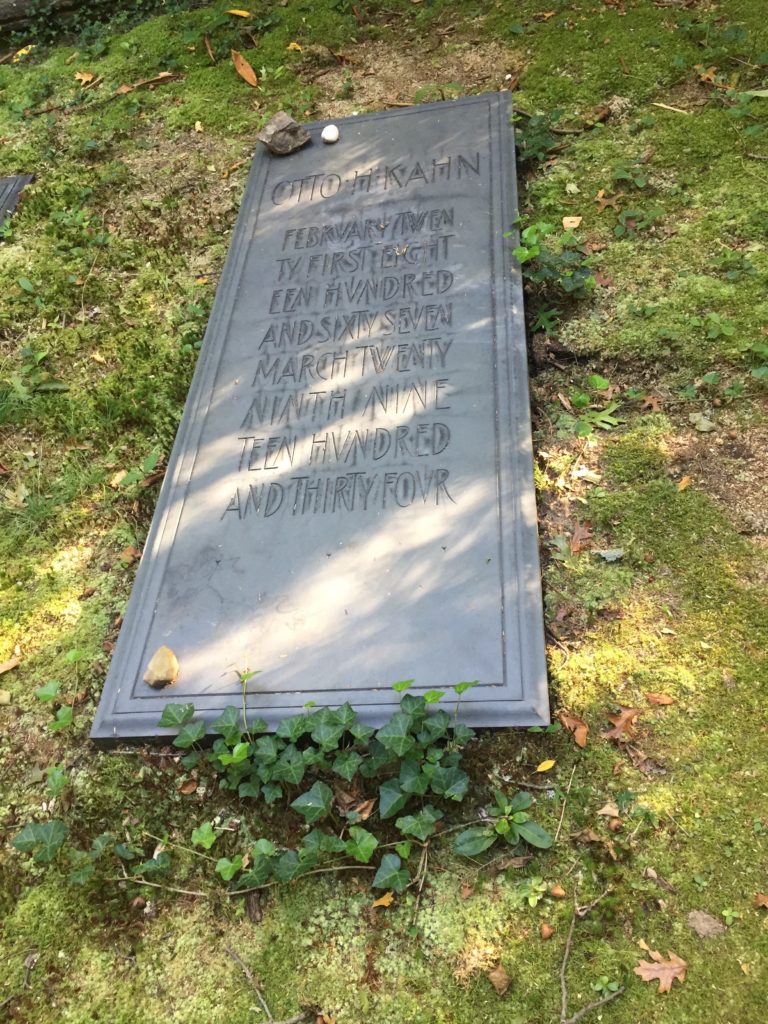Erik Visits an American Grave, Part 971
This is the grave of Otto Kahn.

Born in 1867 in Mannheim, Germany, Kahn grew up there in a well-off Jewish family. His father had actually fled Germany to the U.S. after the 1848 revolutions for political reasons, but returned to his home country. Many immigrants did this and we often forget this when we talk about immigration history. Kahn wanted to be a musician. His father wasn’t having it. He wanted his boy to be a banker. And so he was trained in finance. After a year of Army service, he went to London to work in finance, working for Deutsch Bank, long before they funded Donald Trump. He loved Britain and became a citizen, as well as one of the top leaders of the bank there.
In 1893, Kahn moved to the United States, when the firm Speyer and Company offered him a good job. He never did return to Europe to live, finally becoming a U.S. citizen in 1917. He was a genius financier in an era where competence was in short supply. The railroads were particularly a mess, with an overbuilt infrastructure that served the short-term interest of capitalists seeking to compete with each other and often just steal the money. The railroads had caused the Panic of 1873 and Panic of 1893, leading to tremendously hatred of them among many Americans (think Frank Norris’ The Octopus as just one example). Kahn became close with railroad capitalist E.H. Harriman and together they sought to rationalize the American rail system, with great profits to both of course.
Kahn was a smooth operator in a world of rough and often poorly educated capitalist. This was very useful to him and his employers. He could operate in the halls of power, not only in the U.S., but in Europe. So, for instance, he opened the Paris Bourse, the French securities market, to American investments for the first time. Kahn’s long career meant he was around for the Great Depression too and his ability to handle (and let’s be honest, manipulate) anger members of Congress did a lot to save the banking industry from more (and probably quite needed) regulation. Given that like any other capitalist he hated government intervention in the economy, he served his masters as well, while being a master himself. It goes without saying that Otto Kahn was not a big fan of labor unions.
Being a German, Kahn could have come under suspicion for his loyalties in World War I. But not only did he had no love for the Kaiser, he gave millions of dollars to war relief efforts and this made him one of the most lauded German-Americans during the war. However, he was no internationalist government guy. He strongly opposed the League of Nations and other international organizations. However, he also urged a deal by which governments would cancel all war debts if those European nations would disband their armies. That wasn’t going to happen.
If anything, Kahn is probably more known today for being a big time supporter of the arts than he is for how he actually made his money. He became chairman of the Metropolitan Opera and VP of the New York Philharmonic. He thought Hollywood was great and so he invested in the movies. He personally supported people such as George Gershwin and Arturo Toscanini. In fact, his son Roger became a reasonably well-known jazz band leader in the 20s. Kahn may well have regretted not becoming a full-time musician and he wasn’t going to drive his kids into business if they didn’t want to go, though to be fair, having millions of dollars at your disposal meant he didn’t have to. For Kahn, art was a civilizing force. That meant that while he was a high art guy, he also thought movies and comedy had positive social functions. Some of his charity was also his way to fight anti-Semitism. For Kahn, each act of charity was another step toward social acceptance for himself and Jews generally.
Kahn is also remembered for his giant houses. He had the second largest private home in the U.S., out on Long Island. Only the Vanderbilt’s Biltmore estate was larger. How large was Oheka Castle? Oh, a mere 109,000 square feet. His home in New York still stands as well.
Kahn was also a prolific writer, though mostly of books no one has any reason to read today. Among his books are Art and the People (1916), Right Above Race (1918), Our Economic and Other Problems (1920),The Myth of American Imperialism (1925), and Of Many Things (1926).
Supposedly, Kahn is the model for the Monopoly guy.
Kahn was a workaholic. This meant he didn’t take care of himself very well. He had very high blood pressure and developed a lot of heart problems. When his doctors told him to rest so that he wouldn’t die, he suffered dearly, being tremendously bored by anything that wasn’t work. And of course for a guy like this, his patronage of the arts was also work. He and his family traveled a lot in Europe because that’s what you were supposed to do, but for Kahn, these weren’t exactly vacations. In 1934, he died of a massive heart attack. He was 67 years old.
Otto Kahn is buried in St. John’s Memorial Cemetery, Laurel Hollow, New York.
If you would like this series to visit other bankers, you can donate to cover the required expenses here. Prescott Bush is in Greenwich, Connecticut and Amadeo Giannini is in Colma, California. Previous posts in this series are archived here.


